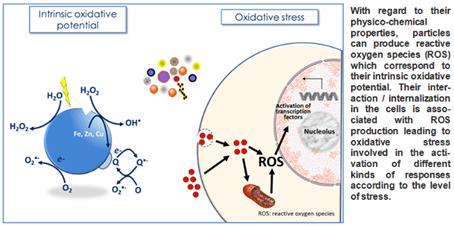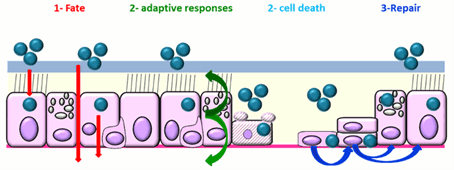1/ Evaluation of the pulmonary toxicity of atmospheric pollutants using in vitro models
S BOLAND, S DEVINEAU, K MAOUCHE, F MARANO, J RENAULT (Bioprofiler resource)
Human activities (industry, transport) and in particular the use of nanotechnologies are leading to an increase in people’s exposure to atmospheric particulate pollutants and manufactured nanomaterials. The epithelial cells lining the respiratory tract, which are the targets of inhaled particles, develop specific responses to this type of exposure.
Our research aims to link the nature of the biological responses observed with certain physico-chemical characteristics of the particles (chemical composition, size, specific surface area, surface reactivity, crystallinity, shape, oxidising potential, etc.). We are interested in manufactured nanoparticles as well as those produced unintentionally by combustion processes (diesel engines, chimney fires) or wear and tear (brake pads).
We are seeking to gain a better understanding of the cellular and molecular mechanisms induced by these particles and, in particular, their ability to generate oxidative stress, whether or not associated with their intrinsic oxidative properties.


Oxidative stress can activate signalling cascades that can lead to adaptive responses or cell death. We are also interested in the nucleolus, the area of the cell nucleus dedicated to ribosome biogenesis and considered to be a sensor of cellular stress.
We are favouring in vitro approaches in order to study the direct effect of particles on respiratory epithelial cells, using lines as well as primary cultures of human bronchial epithelium. The latter are capable of differentiating in vitro and developing a mucociliary epithelium that can be kept for several months in culture, making them suitable for studies of repeated exposure to low doses and long-term effects.
The team’s work focuses in particular on :

the mechanisms of internalisation and passage of particles through the respiratory epithelial barrier
the study of adaptive responses (such as the induction of antioxidant defences and pro-inflammatory responses) and cell death induced by particles and the cell signalling pathways involved.
the effect of particles on the repair and protection functions of the epithelial barrier and their impact on the differentiation of the respiratory epithelium, using -omics approaches in particular on the epithelial secretome.
The modulation of these different effects by the interaction of particles not only with biomolecules (lipids, proteins) forming a corona around the particle but also with xenobiotics.
Our research aims to contribute to the establishment of AOPs (Adverse Outcome Pathways) both by elucidating the mechanisms of action and by developing 3D cellular models.
